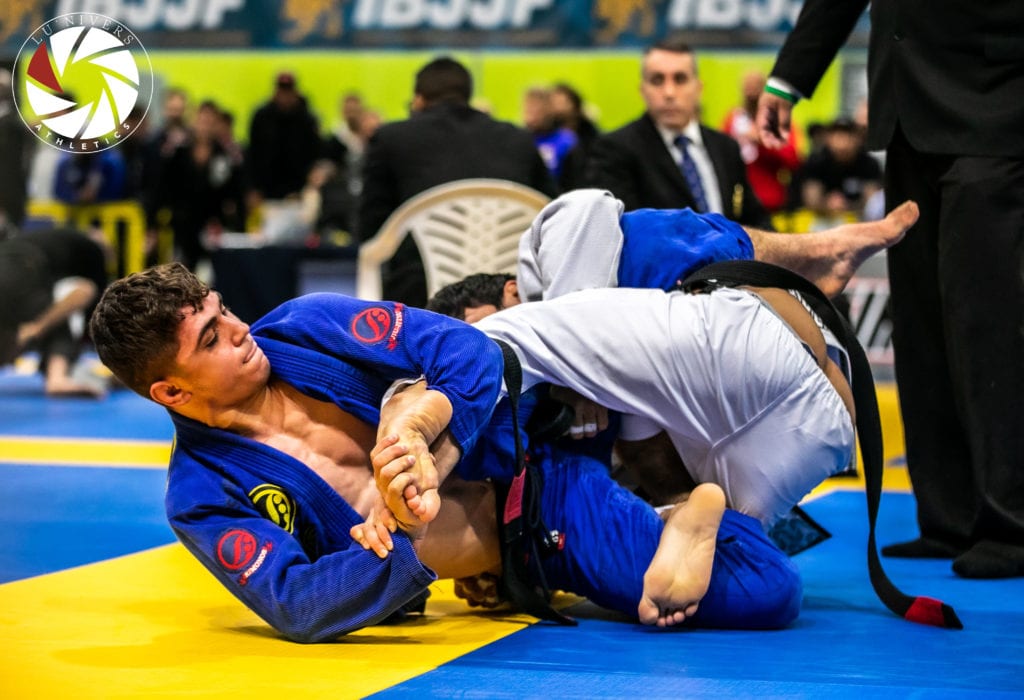The toe hold submission is a staple of BJJ and Submission Grappling. It has proven itself at the highest levels of competition in gi, no-gi, as well as MMA. As with all twisting foot locks, it is a technique that can cause some serious damage. Being familiar with it, both offensively and defensively, is critical for any BJJ practitioner.
The toe hold is a great addition to anyone’s game, and even if you aren’t interested in using foot locks as submissions, toe holds can help you sweep, pass, or attack upper body submissions. Keep reading to learn more about this powerful, yet underused submission.
History and Origins of the Toe Hold
The toe hold has likely been around in grappling since people began wrestling with submission holds. In BJJ, it was taught in the earliest days of the art, although neither Mitsuo Maeda nor the Gracie brothers were fans of foot locks.
The late Rolls Gracie was incredibly open minded and popularized the toe hold (as well as the triangle!) within BJJ. Rolls spent a lot of time training in other grappling arts, such as Judo, Sambo, and wrestling, and reading about other martial arts, and would bring techniques back to BJJ.
While most of Helio Gracie’s family are known for their dislike of foot locks, the most decorated competitor among Helio’s children, Royler Gracie, had a penchant for using them.
During Royler’s famous run of 3 consecutive ADCC gold medals at -66kg, as well as 4 World Titles at featherweight in the gi he relied heavily on the toe hold and straight ankle lock. Royler was a great early player of leg entanglements and foot locks.
Toe Hold Basics Mechanics
The basic mechanics of the toe hold are very similar to the outside heel hook, but you’re using your hands and arms to apply the finishing mechanics instead of your torso. A very common mantra is to “push the toes to the butt” which is honestly a bit antiquated.
The strongest mechanics involve pulling strongly with your support arm – not simply pushing. So, if you’re holding your opponent’s right toes with your left hand, and you’re gripping your left wrist with your right hand, then your right arm is going to perform a retraction (pull) of the elbow, as you slightly press (push) their toes to their butt with your left hand.
How does a toe hold work?
The toe hold works by applying medial rotation to the foot, in order to attack the ligaments in the ankle and the foot (Talocrural joint and the Subtalar joint). This results in an injury of the ATFL (Anterior talofibular ligament) and/or the CFL (Calcaneofibular ligament).
In plain speak, toe holds cause the same sort of injury that rolling your ankle does. The submission also has a possibility for the pressure to travel up the shin and into the knee, which can cause damage to the collateral ligaments inside the knee.
Grips
The grip for the toe hold is very easy to remember. Think of it as a kimura submission against the opponent’s foot. One hand presses down on the toes, and the other hand reinforces your grip at the wrist.
Body position
The ideal body position for the toe hold occurs when you have some form of leg entanglement, more formally called ashi garami. There are multiple subsets of ashi garami, and the most common for this particular leg lock are the straight ashi, outside ashi, and rear ashi.
Leg placement
The body positioning and leg placement sort of run hand in hand, but the ideal leg placement for finishing the submission, for most high-level players, seem to be the outside ashi and the rear ashi.
The outside ashi is powerful, but can leave your back exposed. The rear ashi tends to be a bit safer for preventing your back’s exposure, but there’s also a little less horsepower on the submission itself.
Setting up the Toe Hold Submission From The Top
Great setups for toe holds from top position typically involve the same situations where someone would fall back for ashi garami, a straight ankle lock, or dive for a kneebar.
Entries versus the De la Riva guard against the opponent’s non-hooking leg are very powerful. As their non-hooking foot is monitoring your thigh/hip, it’s ripe for wrapping up with a toe hold. It can also be attacked when your opponent is playing inverted guard.
One of the strongest plays from the top is to rotate your torso and reach back to attack it versus Z-guard situations. Even if you can’t get the submission, your opponent will be forced to straighten their leg to defend the attack, helping you pass their guard.

Setting up the Toe Hold Submission From The Bottom
Bottom toe hold entries are probably more common than entries from the top. Any situation that involves rolling underneath your opponent’s legs to wrap them up in ashi situations is good for toe holding.
Rolling under to the rear ashi position is becoming especially popular, and you can see this style entry in recent Garry Tonon matches against JT Torres at ADCC 2019, as well as against Ralek Gracie at Metamoris 7.
At the latter, Garry used the submission threat of a toe hold as a setup to finish a kneebar. Toe holds and kneebars go together like peanut butter and jelly, and should be studied together.
Toe Hold Injuries And Dangers
Toe hold injuries can run the gamut from minor to pretty serious. The damage dealt by this submission varies from person to person. If your knee ligaments are stronger, the hold will probably hurt your ankle. If your ankle is stronger, it may hurt your knee.
The real biggest danger comes down to not respecting the submission. Heel hooks are so fashionable these days, and people view the toe hold as lower in the hierarchy of leg locks. Also we don’t see as many toe holds nowadays as we used to, so it’s not on peoples’ minds. Also, as silly as it sounds, the name isn’t exactly intimidating.
Finally, John Danaher and his team stress that while the it isn’t as powerful as the outside heel hook, it can come on much faster. This speed makes this submission dangerous in its own right, and is a boon when you’re in a shootout situation (when both you and your opponent are setting up leg locks).
Defending The Toe Hold
As with all submissions, the best defense is prevention.
For early-stage defense, ‘hiding the heel’ (as you would do to prevent heel hooks) is a great defense. For mid-stage defense, the same ‘heel-slipping’ mechanic that is used against outside heel hooks combined with leaning forward and hand-fighting is a very sound defense.
Straightening the leg can also be a good defense, but you have to be careful not to try this too late. If you try to straighten your leg too late during the submission, it will cause the pressure to bleed from your ankle directly into your knee.
For late-stage defense, you can use your free leg to kick at their grip, using your free foot to disrupt and break apart their grip; proceed with caution when trying this! Toe holds go from 0 to 100 infamously fast.
Finally, the berimbolo is a great movement to counter the submission, and famous berimbolo players (like Rafa Mendes and Paulo Miyao) actually like it when their opponents try toe holds on them, as they believe it assists their berimbolos.
Worst case scenario, the best defense is always to tap and live to roll another day.
Toe Hold Rules: When is it Legal?
The toe hold is illegal in IBJJF for all belts below brown and black belt in both gi and no-gi. It’s also worth noting that the powerful Estima lock is considered a toe hold by the IBJJF, so anyone wondering about Estima lock legality should look to IBJJF’s stance on toe holds for reference.
Toe Holds in Competition
There are also some famous toe holds you can check out at the links below. Possibly the most famous instance in modern Jiu-Jitsu history is when Andre Galvao used one to defeat Pablo Popovitch in their Absolute Finals match at the the ADCC 2011 World Championships. This was Galvao’s final appearance in the brackets at ADCC, and he has been defending the Superfight title ever since.
Davi Ramos is arguably the best toe holder of all time, and taught the setup to Galvao when he joined the Atos team in its earliest days. Davi Ramos would go on to win ADCC himself in 2015 at the -77kg division.
Some other famous toe holds include Cobrinha winning the World Championships over Bruno Frazatto in 2008, and Romulo Barral not submitting to it at the Worlds in 2017, even after his foot was severely dislocated. Here are some videos of my favorite live applications of the submission in matches, and they are time-coded to the correct parts of each match.
Conclusion
While the heel hook has gotten all of the recent publicity, toe holds are a powerful and versatile submission that you should include in your game. Remember to use both of your arms, pushing with one and pulling with the other, to create the most leverage and increase your breaking power.

Drew Foster is a 4-stripe brown belt training out of Wilmington, NC. Drew started training Jiu Jitsu in 2006, and took to the art immediately. Drew has a passion for teaching, as well as a special interest in the history of the art. He frequently contributes to the sub-reddit, r/bjj, and he currently splits his training time between John Salter at Salty Dog Jiujitsu, and Cody Maltais at Elevate MMA
